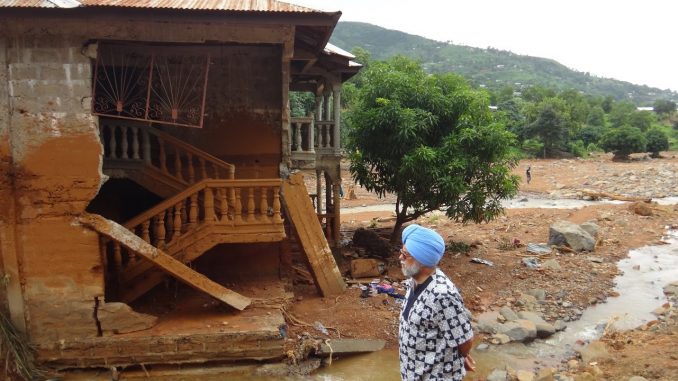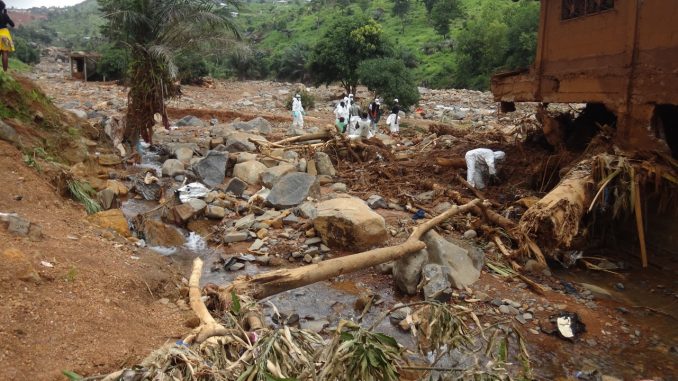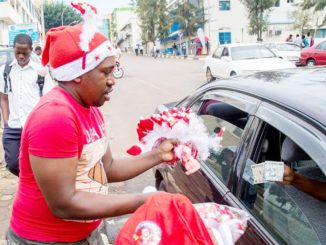
By Mariama Khai Fornah
In continuation of his tour of communities devastated by the August 14 disaster in Freetown, World Bank Country Parminder Brar Friday August 18 visited the Kamayama, Kaningo, Pentagon New Site, and Gbangbayila communities in Lumley, west of Freetown, to assess the scale of destruction caused by intense flooding and a fatal mudslide that claimed the lives of hundreds of residents and homes, leaving in its wake thousands of people homeless.
It could be recalled that on August 17, Mr. Brar visited the Martomeh community at Regent, the scene of a deadly mudslide that buried a whole community at the foot of Mount Sugar Loaf. Friday’s tour of the Lumley community was a continuation of his assessment of the scale of destruction in the affected communities that will inform the Bank’s intervention in helping the government deal with the tragedy.
The Country Manager trekked upstream – starting from the Juba Bridge, up the rocky valley and amidst wreckages of washed-off structures to a place where a large part of the debris and some bodies which drifted from the Martomeh mudslide were deposited. There were several large homes that had been built in the riverbank itself and less than two weeks ago that used to be a thriving community. Medical teams were still recovering bodies from some of these homes.
He stopped over at the Bethel Primary School, which currently provides temporary accommodation for hundreds of people displaced by the disaster. He had a chat with the survivors as he encouraged them to be strong even as they come to terms with the catastrophe that has befallen them and their communities. He assured of the Bank’s support to the government to address the difficulties they are currently faced with.
Mr. Brar was accompanied by some of the survivors as he traversed the length and breadth of the decimated communities. They walked upstream over giant boulders and uprooted trees. They saw firsthand the colossal damage done to lives and property – even as communities, which now risk the outbreak of diseases such as cholera – were coping and starting to rebuild their lives.
Saidu Bangura, a resident at Pentagon who witnessed the dreadful disaster, told the Country Manager that the once sparkling community now lies in complete ruin, being reduced to debris and glimmers of the concrete structures that hitherto dotted the sprawling area. The community hosted hundreds of houses (concrete and makeshift – ‘pan bodies’) but all are now being covered by giant rocks and mud hauled from Mount Sugar Loaf.
“I first saw very thick smoke in the skies and within minutes, there was a deafening blast coming from the Regent end. All we could see now were houses being washed away by floods,” he narrated his ordeal. “The height of the flowing flood water was the reason for the untold destruction that happened; even very big houses were washed away.”
Bangura showed evidence of the destruction from his phone, which he courageously used to film the incident as it unfolded, even as he wrestled with the muddy water to save some of his property. “I saw over 20 people clinging onto branches of a mango tree, crying to be rescued; but the height and volume of the water would not allow anyone to reach them. They were eventually swept away as a giant boulder knocked down the tree,” he further explained.
Bangura, however, has declined the call for affected persons to register to receive relief support as he told the World Bank country boss that he was affected but not as gravely as others who lost entire families and properties. “There are people who badly and urgently need help,” he said and frown at people registering as affected persons when they are not.
Aminata Thulla lost 20 family members to the disaster but only the bodies of seven were recovered. She has lost all hopes of recovering the others. She narrated the miraculous rescue of her younger sibling’s one-month-old baby by a rescue team four hours after he was swept away from the hands of his mother, who didn’t survive the disaster. The boy is recovering at a private clinic at Lumley.
Unisa Bangura narrowly escaped death. His house, which was located very close to a running stream, didn’t take long to be overwhelmed by the floods. He said he had decided to go back to sleep after performing the early morning Muslim prayers but he could barely touch the bed when he heard a loud blast. “I rushed outside to see what was happening and I saw water and rocks pounding houses,” he said. “Then I realized we are in serious trouble. I had to dash for safety, leaving behind all that I had worked for in my entire life.”
He said majority of residents at Kamayama and neighboring communities are poor people, and may have formed a large percentage of victims of the disaster. He said the community was congested with houses and people because acquiring land there was cheap.
Many other affected people shared their testimonies about the horror they endured during the disaster.
Kamayama community and its neighbors face a serious challenge to access potable water as the water wells that existed were either destroyed or left seriously contaminated. The Ministry of Health and Sanitation has warned Freetown residents against drinking water from unsafe sources as disease outbreak looms large until the sanitation problems left behind by the flooding and mudslide disaster are urgently dealt with by the authorities.
The government is yet to confirm total figures of the death toll. The Deputy Minister of Information and Communications, Cornelius Deveaux, said 496 bodies have been buried as efforts continue to recover more bodies believed to be buried under the mud and giant rocks.
Hundreds of victims are still unaccounted for and some families have almost given up hope of ever finding the bodies of their loved ones.




